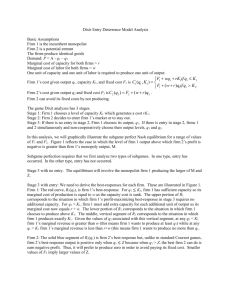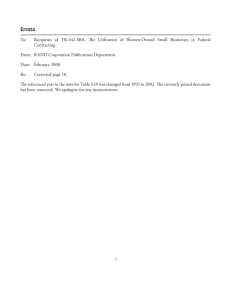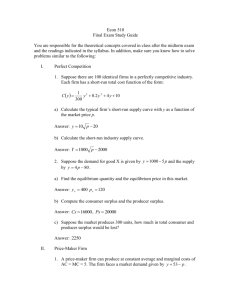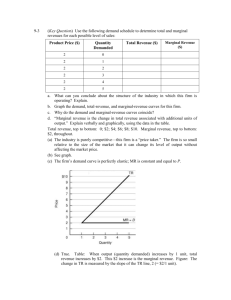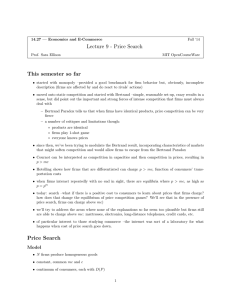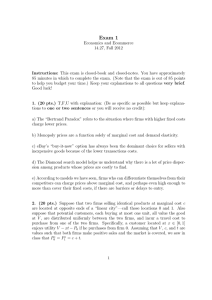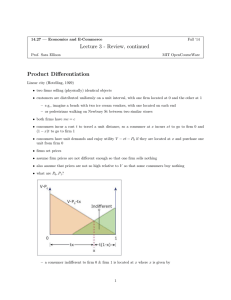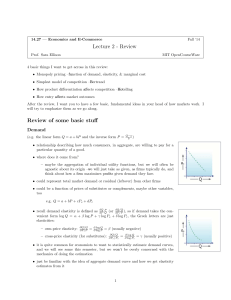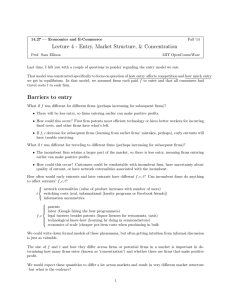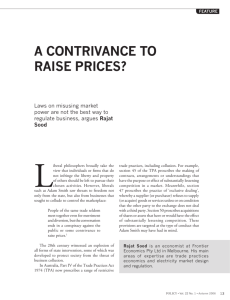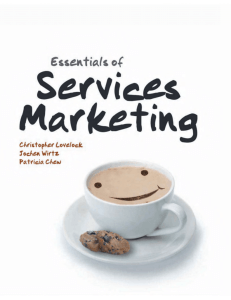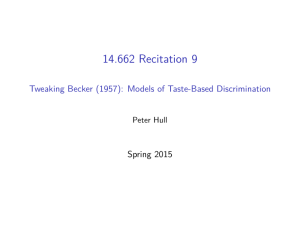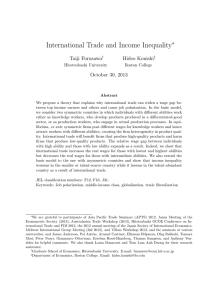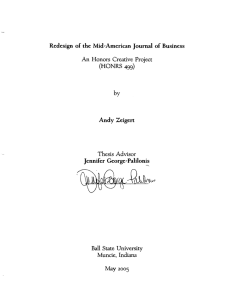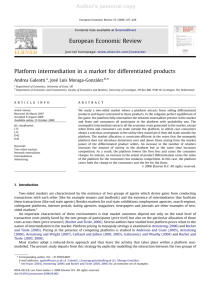Lecture 11 - Department of – Economics
advertisement
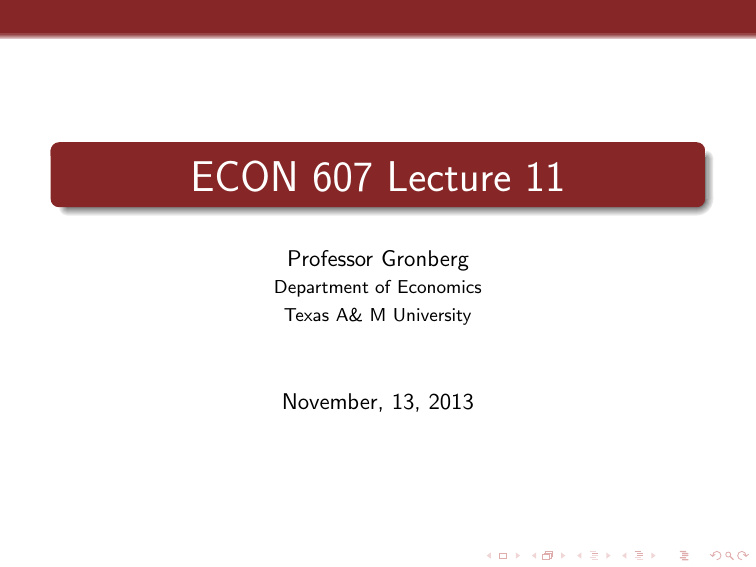
ECON 607 Lecture 11 Professor Gronberg Department of Economics Texas A& M University November, 13, 2013 Profit-Maximizing Firm Model Profit Maximization: Cost Function Approach Profit Maximization: One Output Case First Order Condition Second Order Condition Marginal Revenue/Marginal Cost Analysis Short-Run Supply Curve for a Price-Taking Firm Avoidable versus Unavoidable Fixed Costs Shutdown Decision (Nicholson Figure 11.3) Producer Surplus Definition Short Run Example Competitive Industry/Market Supply with a Fixed Number of Firms Key Assumptions: 1. Large number of profit-maximizing firms producing homogeneous product. 2. Each firm is a price-taker. 3. Information is perfect and transactions are costless. Competitive Industry/Market Supply with a Fixed Number of Firms The industry supply function is simply the sum of the individual j firm supply functions. If qj (p) is the supply function of the jth firm in an industry with J firms, the industry supply function is given by Q(p, J) = qj (p). Competitive Industry/Market Supply with a Fixed Number of Firms The inverse supply function for the industry is just the inverse of this function: it gives the minimum price at which the industry is willing to supply a given amount of output. Example: Identical cost functions Suppose that there are J firms that have the common (short run) cost function c(q) = q 2 + 1. Competitive Industry/Market Supply with a Fixed Number of Firms The marginal cost function is simply MC(q) = 2q, and the average variable cost function is AV C(q) = q. Since in this example the marginal costs are always greater than the average variable costs, the inverse supply function of the firm is given by p = MC(q) = 2q. Competitive Industry/Market Supply with a Fixed Number of Firms It follows that the supply function of the firm is q(p) = p/2 and the industry supply function is Q(p, J) = Jp/2. The inverse industry supply function is therefore p = 2Q/J. Competitive Industry/Market Supply with a Fixed Number of Firms Example: Different cost functions Consider a competitive industry with two firms, one with cost unction c1 (q) = q 2 , and other with cost function c2 (q) = 2q 2 . The supply functions are given by q1 = p/2 q2 = p/4. Competitive Industry/Market Supply with a Fixed Number of Firms The industry supply curve is therefore Q(p) = 3p/4. For any level of industry output Q, the marginal cost of production in each firm is 4Q/3. Industry producer surplus Competitive Industry/Market Supply with a Fixed Number of Firms Following figures from Microeconomics by Goolsbee, Levitt, and Syverson, Worth Publishing, 2013 Competitive Market Equilibrium with Fixed Number of Firms The industry supply function measures the total output supplied at any price. The industry demand function measures the total output demanded at any price. An equilibrium price is a price where the amount demanded equals the amount supplied. Competitive Market Equilibrium with Fixed Number of Firms If we let x(p) be the demand function of individual i for i = 1, ..., n and q(p) be the supply function of firm j for j = 1, ..., J, then an equilibrium price is simply a solution to the equation qj (p). xi(p) = Competitive Market Equilibrium with Fixed Number of Firms Example: Identical firms Suppose that the industry demand curve is linear, X(p) = a − bp, and the industry supply curve is that derived in the last example, Q(p, J) = Jp/2. Competitive Market Equilibrium with Fixed Number of Firms The equilibrium price is the solution to a − bp = Jp/2, which implies p∗ = a/(b + J/2). Note that in this example the equilibrium price decreases as the number of firms increases. Competitive Market Equilibrium with Fixed Number of Firms For an arbitrary industry demand curve, equilibrium is determined by X(p) = Jq(p). How does the equilibrium price change as J changes? Competitive Market Equilibrium with Fixed Number of Firms We regard p as an implicit function of J and differentiate to find X (p)p (J) = Jq (p)p (J) + q(p) which implies p (J) = q(p)/(X (p) − Jq (p)). Assuming that industry demand has a negative slope, the equilibrium price must decline as the number of firms increases. Free Entry and Long Run Competitive Equilibrium 4 Key Assumptions 1. Infinite number of potential firms 2. Access identical “best” technology 3. No Technological Externalities 4. Input Prices Fixed to Industry (horizontal industry input supply curves) Free Entry and Long Run Competitive Equilibrium Given X(p), c(q) with c(0) = 0, (p∗, q ∗, J ∗) is a Long Run Competitive Equilibrium if i. q ∗ solves Max p∗ q − c(q) ii. X(p∗) = J ∗ q ∗ iii. p∗q ∗ − c(q ∗ ) = 0 At p∗ , X(p) = Q(p), where Q(p) is the long run industry/market supply curve. Free Entry and Long Run Competitive Equilibrium Standard Case: Let c(q) = K + f (q) if q > 0, c(q) = 0 if q = 0, where f (0) = 0, f > 0, f > 0. Then there exists a unique efficient scale qm where long run average cost is minimized at a value cm . Free Entry and Long Run Competitive Equilibrium Then Q(p) = ∞ if p > cm = Q ≥ 0 : Q = Jqm for some integer J ≥ 0 if p = cm = 0 if p < cm So Long Run Competitive Industry Supply Curve is “approximately” horizontal at the entry price p = cm . More on Long Run Competitive Industry Supply Conclude that, in general, with homogeneous firms, free entry long run competitive equilibrium implies that supply curves are perfectly elastic. Three common avenues to upward-sloping long-run aggregate supply: 1. Assume that the industry faces an upward-sloping supply curve for some input. 2. Assume heterogeneity in costs across firms. 3. Assume that entry is limited (and assume increasing marginal costs) More on Long Run Competitive Industry Supply Case 1: Endogenous factor price This is the Increasing Cost Industry case on pp.428-29 of N& S, 11th edition. More on Long Run Competitive Industry Supply Case 2: Heterogeneity Suppose firms differ in cost efficiency. Figure 7.7 from Layard and Walters More on Long Run Competitive Industry Supply Long Run Producer Surplus and Economic Rents This material goes with the Ricardian Rent case on pp. 436-438 of N& S, 11th edition. More on Long Run Competitive Industry Supply Case 3: Limited Entry If we maintain the price-taking behavioral assumption, and if a limited number of firms have convex costs, then industry has upward sloping supply with dQ/dp = J/c (q) where J is the number of firms and C (q) is the second derivative of the firm cost function. Are profits zero? Application: U.S. Sugar Market Program Analysis This application is based on Lecture Note 8 for the course Applied Microeconomics and Public Policy (MIT 14.03) authored by Professor David Autor. The material is available for use under the MIT Open Course Ware initiative and distributed to you under the agreements described in the following link: http://ocw.mit.edu/terms. Autor: Lecture Note 8: http://tinyurl.com/AutorLec8




